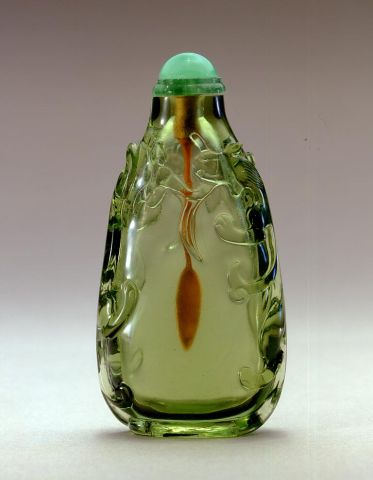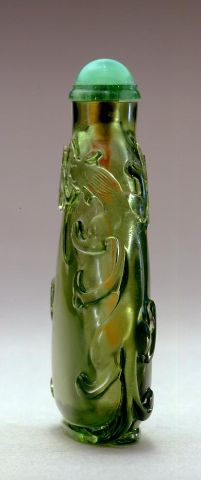

Bottle ID: 00422
GREEN EMERALD, PEAR SHAPE, CARVED W/CHI DRAGON
Date: 1740-1840
Height: 67 mm
Glass, of flattened pear shape tapering to an oval neck, of transparent emerald-green tone, carved in low relief along each narrow side with a chi dragon holding lingzhi fungus in its mouth, their heads reaching onto the upper main side in each case, their tails curling around to form the footrim.
Imperial, attributed to the Palace Workshops, Beijing.
Similar Examples:
Crane Collection no. 229
Beaussant Lefevre, Paris, November 18, 2005, lot 148.
Christie's, London, October 12, 1987, from the Estate of Edmund F. Dwyer, lot 27.
Hui, Humphrey K. F., Margaret Polak and Christopher C. H. Sin. Hidden Treasures of the Dragon - Chinese Snuff Bottles from the Collections of Humphrey K. F. Hui, Margaret Polak, and Christopher C. H. Sin, 1991, p. 16, no. 16.
Provenance:
Hugh Moss [HK] Ltd.
Robert Hall
The Clatworthy Collection
Exhibited:
Annual Convention ICSBS Toronto, October 2007
This finely carved glass bottle belongs to a group of bottles in colors such as green, pale blue, red, white, and purple, which are generally thought to have been carved from a solid block of glass. This is said to be indicated by the heavy weight in relation to the thickness of the glass walls and the interior surface of the glass which can exhibit some polishing marks. There is no conclusive evidence for this, nor any apparent documentary evidence. However, by the end of the eighteenth century, jade workers were employed in the cutting and grinding rooms of the Palace Workshops to finish glass objects, including snuff bottles. Since the Workshops appeared to have experimented, mostly with great success, with every type of glass making technique and style, both domestic and Western, it is entirely possible that the word of mouth information given in this case is the accurate one. As a rule, the group consists overwhelmingly of green glass bottles such as this example, all with chi dragons carved along their narrow sides. There is also a small number known in pale blue and the likelihood is that both colors were used to imitate beryl and aquamarine respectively. A number of similar eighteenth century Imperial bottles in these materials, carved with chi dragon sides, exist in private collections providing the models for these glass examples. This is one of the finest of the glass group, being of an intense emerald-green color and of a more imposing size than is usual, and with the unusual feature of the two lingzhi filling the upper body of the bottle around the shoulders.
< Back to full list

 English
English 中文
中文